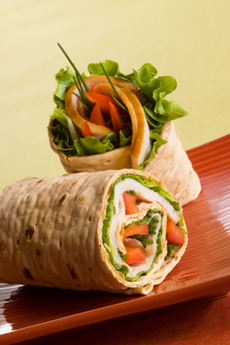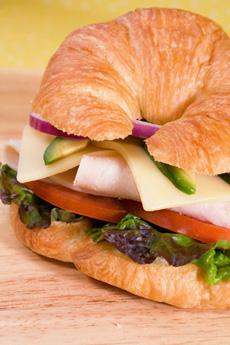
 Who invented the wrap sandwich? The name of the creative genius who first rolled sandwich ingredients in a tortilla, though relatively recent, is lost to history. Photo by FoodCloud | IST.
Who invented the wrap sandwich? The name of the creative genius who first rolled sandwich ingredients in a tortilla, though relatively recent, is lost to history. Photo by FoodCloud | IST.
September 2009
Last Updated April 2018
|
 |
Sandwich History Continued
Page 2: The Sandwich In America
This is Page 2 of a two-page article. Click on the back links below to visit other pages.
Americas Develops Regional Specialty Sandwiches
Ham and cheese, club sandwiches, falafel and croque monsieur are European creations, but there are some American classics. Cream cheese was invented in New York state in 1872, but became mass marketed by Philadelphia Brand in 1928. The cheesesteak, the hamburger, hot dog, peanut butter sandwich and sloppy joe were U.S. inventions. Hot sandwiches became popular with the rise of the luncheonette in the 1920s. Warm meat could be carved and placed on a sandwich, topped with hot gravy.
Then there’s the mega-sandwich group (hoagie, grinder, submarine, etc.).While “Italian sandwiches” on oblong, crusty bread were known as early as 1910, based on recipes from the Old Country, the era around World War II engendered creativity in adapting them with new names. Depending on the city, a sandwich on long, narrow roll became variously known as a grinder, hero, hoagie, po’ boy, torpedo and submarine. You can read the genesis of each in the Sandwich Glossary.
Along with this type of regional adaptation came specialties such as:
- the Denver Omelet, an omelet on toast
- the Fluffernutter, peanut butter and Fluff marshmallow creme, a New England invention
- the French Dipped Sandwich, created in Los Angeles in 1918, thinly sliced roast beef served on a French roll or baguette au jus
- the Muffaletta from New Orleans, with ingredients similar to a hero or sub but served on a slice cut from a loaf of round Sicilian muffaletta bread instead of a long roll
- the Philadelphia Cheesesteak, thin slices of grilled steak with melted cheese on a roll
- the Reuben Sandwich from New York City—pastrami, sauerkraut and melted cheese on pumpernickel or rye bread
While most Americans may not have had one particular southern favorite, a fried peanut butter and banana sandwich, it was made famous by Elvis Presley—it was his favorite sandwich.
America’s overall favorite sandwich cuts across regions. The peanut butter and jelly sandwich was created by World War II soldiers, who combined the crackers, peanut butter and jelly from their C-Rations. When they returned home, they brought the concept with them—and fresh bread provided a superior alternative to the mess kit crackers.
The Bread Explosion
The postwar boom and immigration created more opportunities for experimentation. Chefs from Europe emigrated to America, bringing their traditions with them. The first Baby Boomers graduated from college in the 1960s, traveled to Europe and elsewhere abroad and returned with a desire for the exciting foods they experienced. The growing culinary arts movement of the 1970s introduced many types of bread to more Americans. Beyond the white bread and wheat bread, rye bread, “French bread” baguette and “Italian bread” crusty loaf that many Baby Boomers and their parents grew up with.
San Francisco sourdough radiated east as New York bagels, pumpernickel and Reuben sandwiches headed west and south. Pita, focaccia and tortillas expanded beyond ethnic enclaves into major regional supermarket chains. California Cuisine and the growth of vegetarianism, from which emerged healthier and more flavorful multigrain loaves. Avocado and sprouts sandwiches and grilled vegetable sandwiches crossed California to borders to national popularity.
The 1970s was the decade of sandwich explosion, with shops and chains dedicated to bagelwiches, croissandwiches, wrap or roll-up sandwiches made with tortillas, falafel and other pita sandwiches, Mexican tortas, Indian kathi rolls and the emergence of bánh mì in cities with Vietnamese communities.
Just as exciting, the demand by restaurants and consumers for fine bread grew to the point where culinary students specialized in bread and opened artisan bakeries. By the 1980s, in many cities, it was no longer necessary to go to Europe to get a great croissant or brioche or a fine loaf of bread.
There are many more than 65 types of sandwiches served in the U.S., but check out the 65 or so featured in our Sandwich Glossary. Be part of sandwich history: Try them all!
|
|

The croissant sandwich or croissandwich. Photo © DreamBigPhotos | Fotolia. |
Lifestyle Direct, Inc. All rights reserved. Photographs are the copyright of their respective owners.

|





